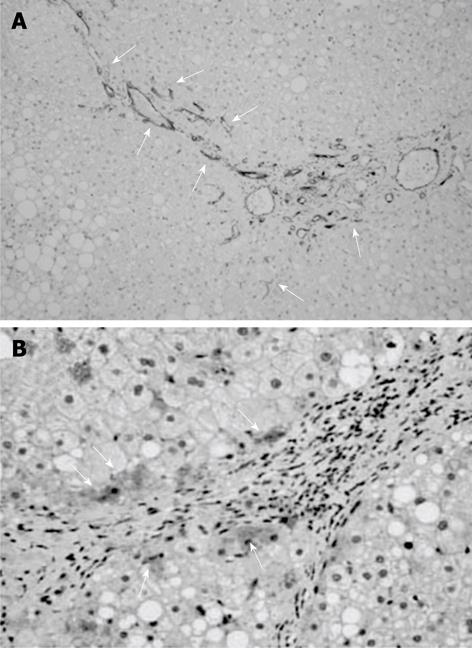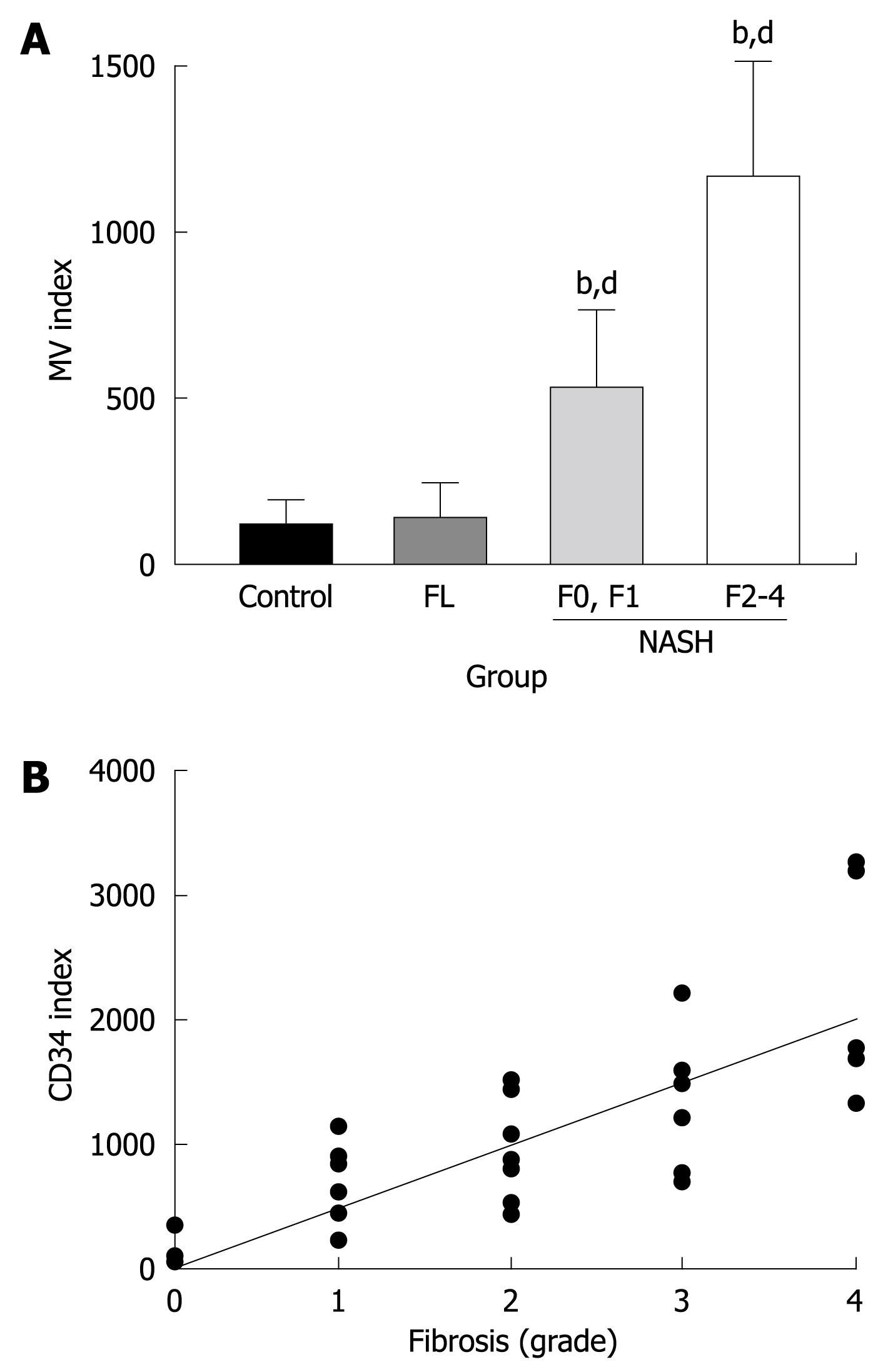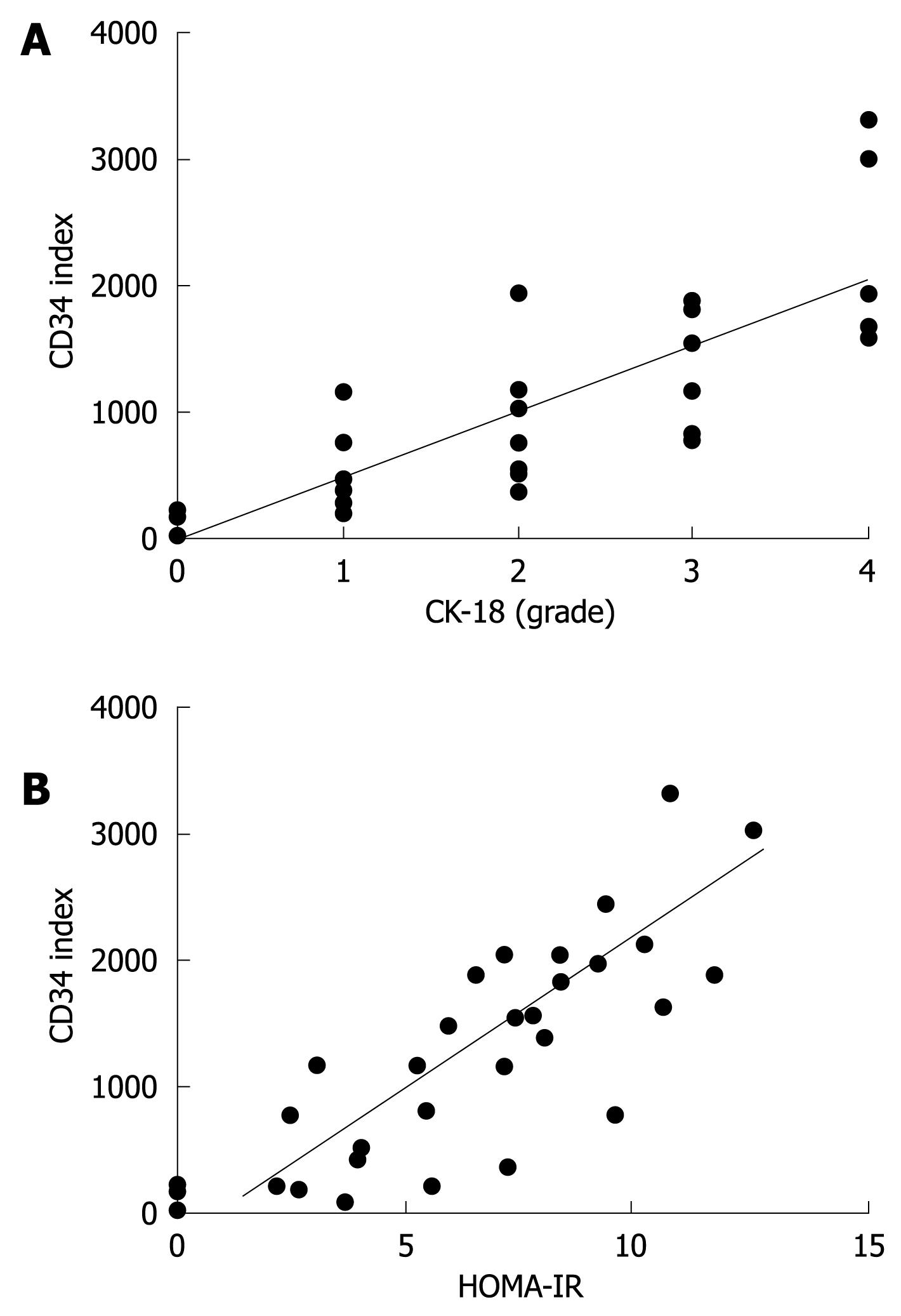Copyright
©2009 The WJG Press and Baishideng.
World J Gastroenterol. Nov 7, 2009; 15(41): 5193-5199
Published online Nov 7, 2009. doi: 10.3748/wjg.15.5193
Published online Nov 7, 2009. doi: 10.3748/wjg.15.5193
Figure 1 Representative microphotographs of CD34-positive neovessels and cytokeratin-18 (CK-18)-positive cells in the liver of patients.
A: Marked CD34-positive immunopositive vessels could be found in NASH along with liver fibrosis development; B: The immunopositivity of CK-18 was mainly observed in the hepatocytes. The arrows indicate CD34 and CK-18-immunopositivity in A and B, respectively. The original magnification was × 100.
Figure 2 Semi-quantitative analysis of CD34 and possible correlation with liver fibrosis development.
A: Semi-quantitative analysis of the CD34-positive neovessels in the liver in non-alcoholic fatty liver disease (NAFLD). There was no difference between the control healthy liver and simple FL. In NASH, a marked augmentation of neovascularization was found in the liver of NASH as compared with FL. The magnitude of neovascularization in high-grade (F2 to F4) liver fibrosis was more than in low-grade (F0, F1) fibrosis. The proportional increase in neovascularization was almost parallel to the development of liver fibrosis. bP < 0.01 vs control group; dP < 0.01 vs low-grade fibrosis with NASH group. The number of patients in each group was as follows: Control (n = 3), FL (n = 11), low-grade fibrosis (F0 and F1: n = 10), and high-grade fibrosis (F2 to F4: n = 18). MV: Microvessel density; B: The relationship between the development of CD-34-positive vessels and fibrosis grade in NAFLD. The degree of angiogenesis correlated with the development of fibrosis. The equation was y = 509.82x - 6.7958. The correlation coefficient was 0.6288.
Figure 3 Semi-quantitative analysis of the CK-18-positive cells in the liver (A) and HOMA-IR (B) in NAFLD.
Similar to the CD34-positive neovascularization, there was no difference between the control healthy liver and FL. In NASH, a marked augmentation of CK-18 (A) and HOMA-IR (B) was found in the liver of NASH as compared with FL. The magnitude of neovascularization in high-grade (F2 to F4) liver fibrosis was more than in low-grade (F0, F1) fibrosis. The number of patients in each group was as follows; C (n = 3), FL (n = 11), low-grade fibrosis (F0 and F1: n = 10), and high-grade fibrosis (F2 to F4: n = 18). bP < 0.01 vs control group; dP < 0.01 vs low-grade fibrosis with NASH group.
Figure 4 The relationship between angiogenesis, CK-18-positive vessels (A), and HOMA-IR (B).
The degree of angiogenesis correlated with the CK-18-positive cells (A) and HOMA-IR (B). A: The magnitude of expression of CK-18 correlated positively with CD34-positive neovascularization. The equation was y = 500.63x + 4.6606. The correlation coefficient was 0.6512; B: Similarly, there was a positive correlation between HOMA-IR and hepatic neovascularization. The equation was y = 233.75x - 339.39. The correlation efficient was 0.6184.
- Citation: Kitade M, Yoshiji H, Noguchi R, Ikenaka Y, Kaji K, Shirai Y, Yamazaki M, Uemura M, Yamao J, Fujimoto M, Mitoro A, Toyohara M, Sawai M, Yoshida M, Morioka C, Tsujimoto T, Kawaratani H, Fukui H. Crosstalk between angiogenesis, cytokeratin-18, and insulin resistance in the progression of non-alcoholic steatohepatitis. World J Gastroenterol 2009; 15(41): 5193-5199
- URL: https://www.wjgnet.com/1007-9327/full/v15/i41/5193.htm
- DOI: https://dx.doi.org/10.3748/wjg.15.5193












